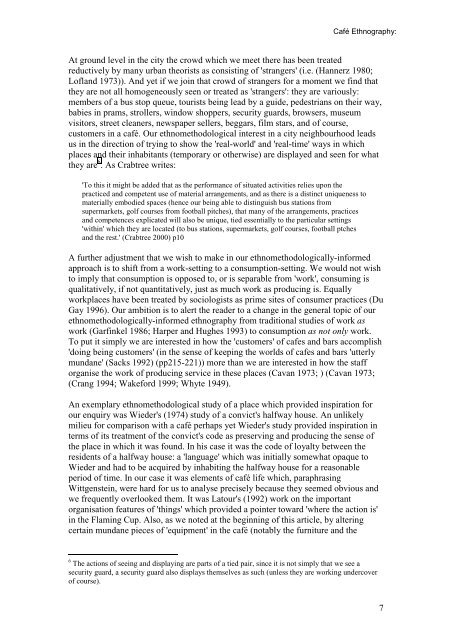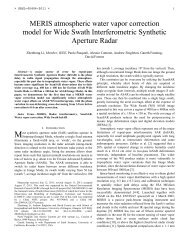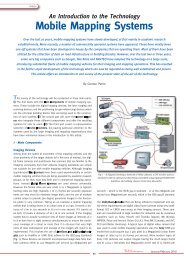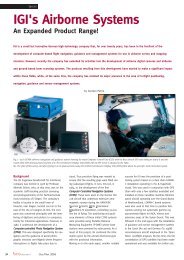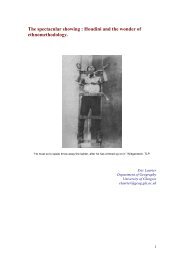Café Ethnography : the uses of tables and chairs
Café Ethnography : the uses of tables and chairs
Café Ethnography : the uses of tables and chairs
Create successful ePaper yourself
Turn your PDF publications into a flip-book with our unique Google optimized e-Paper software.
<strong>Café</strong> <strong>Ethnography</strong>:<br />
At ground level in <strong>the</strong> city <strong>the</strong> crowd which we meet <strong>the</strong>re has been treated<br />
reductively by many urban <strong>the</strong>orists as consisting <strong>of</strong> 'strangers' (i.e. (Hannerz 1980;<br />
L<strong>of</strong>l<strong>and</strong> 1973)). And yet if we join that crowd <strong>of</strong> strangers for a moment we find that<br />
<strong>the</strong>y are not all homogeneously seen or treated as 'strangers': <strong>the</strong>y are variously:<br />
members <strong>of</strong> a bus stop queue, tourists being lead by a guide, pedestrians on <strong>the</strong>ir way,<br />
babies in prams, strollers, window shoppers, security guards, browsers, museum<br />
visitors, street cleaners, newspaper sellers, beggars, film stars, <strong>and</strong> <strong>of</strong> course,<br />
customers in a café. Our ethnomethodological interest in a city neighbourhood leads<br />
us in <strong>the</strong> direction <strong>of</strong> trying to show <strong>the</strong> 'real-world' <strong>and</strong> 'real-time' ways in which<br />
places <strong>and</strong> <strong>the</strong>ir inhabitants (temporary or o<strong>the</strong>rwise) are displayed <strong>and</strong> seen for what<br />
<strong>the</strong>y are 6 . As Crabtree writes:<br />
'To this it might be added that as <strong>the</strong> performance <strong>of</strong> situated activities relies upon <strong>the</strong><br />
practiced <strong>and</strong> competent use <strong>of</strong> material arrangements, <strong>and</strong> as <strong>the</strong>re is a distinct uniqueness to<br />
materially embodied spaces (hence our being able to distinguish bus stations from<br />
supermarkets, golf courses from football pitches), that many <strong>of</strong> <strong>the</strong> arrangements, practices<br />
<strong>and</strong> competences explicated will also be unique, tied essentially to <strong>the</strong> particular settings<br />
'within' which <strong>the</strong>y are located (to bus stations, supermarkets, golf courses, football ptches<br />
<strong>and</strong> <strong>the</strong> rest.' (Crabtree 2000) p10<br />
A fur<strong>the</strong>r adjustment that we wish to make in our ethnomethodologically-informed<br />
approach is to shift from a work-setting to a consumption-setting. We would not wish<br />
to imply that consumption is opposed to, or is separable from 'work', consuming is<br />
qualitatively, if not quantitatively, just as much work as producing is. Equally<br />
workplaces have been treated by sociologists as prime sites <strong>of</strong> consumer practices (Du<br />
Gay 1996). Our ambition is to alert <strong>the</strong> reader to a change in <strong>the</strong> general topic <strong>of</strong> our<br />
ethnomethodologically-informed ethnography from traditional studies <strong>of</strong> work as<br />
work (Garfinkel 1986; Harper <strong>and</strong> Hughes 1993) to consumption as not only work.<br />
To put it simply we are interested in how <strong>the</strong> 'customers' <strong>of</strong> cafes <strong>and</strong> bars accomplish<br />
'doing being customers' (in <strong>the</strong> sense <strong>of</strong> keeping <strong>the</strong> worlds <strong>of</strong> cafes <strong>and</strong> bars 'utterly<br />
mundane' (Sacks 1992) (pp215-221)) more than we are interested in how <strong>the</strong> staff<br />
organise <strong>the</strong> work <strong>of</strong> producing service in <strong>the</strong>se places (Cavan 1973; ) (Cavan 1973;<br />
(Crang 1994; Wakeford 1999; Whyte 1949).<br />
An exemplary ethnomethodological study <strong>of</strong> a place which provided inspiration for<br />
our enquiry was Wieder's (1974) study <strong>of</strong> a convict's halfway house. An unlikely<br />
milieu for comparison with a café perhaps yet Wieder's study provided inspiration in<br />
terms <strong>of</strong> its treatment <strong>of</strong> <strong>the</strong> convict's code as preserving <strong>and</strong> producing <strong>the</strong> sense <strong>of</strong><br />
<strong>the</strong> place in which it was found. In his case it was <strong>the</strong> code <strong>of</strong> loyalty between <strong>the</strong><br />
residents <strong>of</strong> a halfway house: a 'language' which was initially somewhat opaque to<br />
Wieder <strong>and</strong> had to be acquired by inhabiting <strong>the</strong> halfway house for a reasonable<br />
period <strong>of</strong> time. In our case it was elements <strong>of</strong> café life which, paraphrasing<br />
Wittgenstein, were hard for us to analyse precisely because <strong>the</strong>y seemed obvious <strong>and</strong><br />
we frequently overlooked <strong>the</strong>m. It was Latour's (1992) work on <strong>the</strong> important<br />
organisation features <strong>of</strong> 'things' which provided a pointer toward 'where <strong>the</strong> action is'<br />
in <strong>the</strong> Flaming Cup. Also, as we noted at <strong>the</strong> beginning <strong>of</strong> this article, by altering<br />
certain mundane pieces <strong>of</strong> 'equipment' in <strong>the</strong> café (notably <strong>the</strong> furniture <strong>and</strong> <strong>the</strong><br />
6 The actions <strong>of</strong> seeing <strong>and</strong> displaying are parts <strong>of</strong> a tied pair, since it is not simply that we see a<br />
security guard, a security guard also displays <strong>the</strong>mselves as such (unless <strong>the</strong>y are working undercover<br />
<strong>of</strong> course).<br />
7


